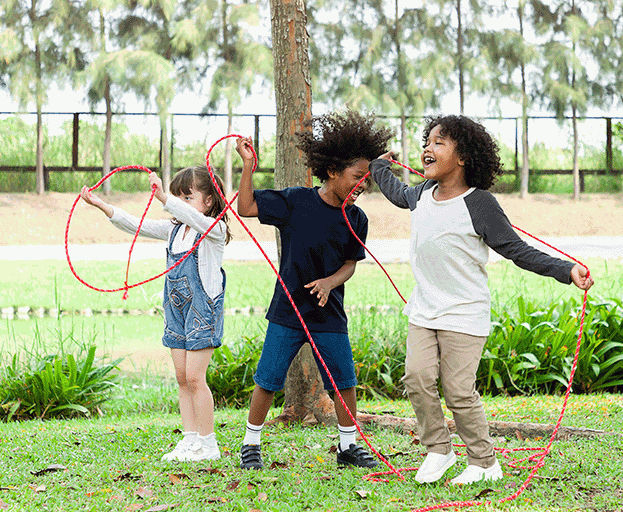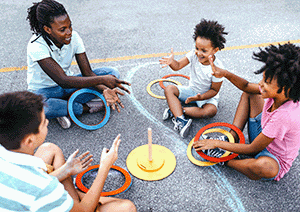Posted: May 23, 2023
Outdoor exploration and play are excellent ways to promote physical activity among the children in your care all year round. As we move toward summer and the weather warms up, it's a great time to think about specific activities that you can incorporate into your daily routine.

Children having fun with a rope outside.
The benefits of outdoor play
While there may be obstacles to incorporating outdoor play into your lessons plans (e.g., weather, space, etc.) there is a great deal of research that has demonstrated the positive impact outdoor play can have on young children's physical health, cognitive development, and social-emotional learning. For example, children who are allowed to play outdoors for part of the day typically demonstrate greater motor skill development and coordination, are at a decreased risk for obesity, have better overall health, and may even sleep better compared to their peers who are not afforded the opportunity to play outdoors! Promoting children's exploration outdoors can encourage using multiple senses to explore the environment, give children an appreciation of nature, provide an opportunity to learn in a different context, and even build attention skills and impulse control, which can make it easier for children to learn even after they've returned to the classroom. Finally, having both unstructured and structured outdoor activities allows children to practice important social-emotional skills like problem-solving and cooperation, and supports children's socialization and friendships.
Ideas for outdoor active play and lessons
There are many ways to get children active and exploring outdoors that vary in their level of structure. Of course, the age of the children in your care should influence both the amount of outdoor time provided as well as the specific activities. All activities should be developmentally appropriate, safe, and have adequate support and supervision from adults. Many young children unfortunately spend hours and hours in front of a screen every single day and only minutes engaging in outdoor play. It is recommended that preschool programs provide a minimum of 30 minutes of outdoor play every day to support children's healthy development. However, most early childhood programs do not meet this threshold. This can be due to a lack of space and resources as well as uncertainty in ways to support children's development through outdoor exploration. While there can certainly be challenges to provide adequate outdoor time, it is important that you are able to find ways around barriers to outdoor play that you encounter. Below are a couple of ideas that you may want to try on your own. And remember there are a lot of different "right" ways to provide time for outdoor play and activities and very few "wrong" ways. Just allowing children the freedom to get outside, move around, and play freely can be a wonderful thing! 
- STEM activities--Children are naturally curious. Giving them the time to explore their environment, ask questions, and observe what they see are foundational STEM skills. If necessary, you can prompt them to use their different senses (e.g., what do you smell, what do you think that sound is) or just be available to have conversations and answer questions about what they notice outside. Take a "nature walk" at a park or around the playground. You can have children draw, write, or even talk about the different things they notice. You'll be amazed what young children notice that you may miss! With summer coming you may also consider doing some planting with the children in your care. Talk about how the soil feels, what the seeds look like, what needs to happen for the seeds to grow, and have children observe and record what they notice over time. There are many, many outdoor STEM activities that are freely available online and require few materials. Also, don't feel like you need to be a STEM expert to do these things. Allowing children to be curious and ask questions is extremely important for children's development and it is always okay to let them know that what they asked was a great question and that you'll find out the answer!
- Physical activity--Engaging children in physical activity outside can look a lot of different ways. Some children may enjoy sports like basketball or playing catch, where others enjoy running around, chasing one another, or playing tag. As long as children are moving and not disrupting others' active play, that's great! Try to focus on fun and inclusion. If you see a child sitting out, think of ways you can get them involved. For children who seem unsure of what to do you can set up hopscotch, an obstacle course with different outdoor materials, or bring music outside for a dance party.
- Free play--Sometimes allowing children to just be children and pick their own play outdoors can be the most effective strategy for getting them moving. Through these unstructured opportunities children can learn important social-emotional skills like taking turns, working collaboratively, making decisions, and being creative! While you should continue to monitor the children in your care to ensure everyone is safe and being treated appropriately, try taking a step back and just observe. It can be incredible to watch the games children come up with and problem-solve. Allowing these opportunities for free exploration can support children's ability to follow directions and control their impulses when it's time to come back into the classroom.
Even when the weather doesn't seem to want to cooperate, it is important that we get children outside to explore and be active. When it's wet or cold or windy, this might change the activities you engage in, but children can still enjoy jumping in puddles, playing in the snow, or flying kites. Hopefully with the warmer weather on the way, this won't be an issue, so let's get outside and get moving! For other ideas about incorporating outdoor activities into your classroom routines be sure to check out the following Better Kid Care professional development courses:
- "Get Outdoors. Explore"
- "I am Moving. I am Learning - Take it Outside!"
- "The Ups and Downs of Outdoor Play"
- "Exciting Backyard Science Activities"
- "Taking Steps to Healthy Success: Active Play"
- "Active Play for Preschoolers with Autism--WE PLAY"
- "Supervision: Playground Supervision"
- "Keeping Children Safe on Playgrounds (for Center Directors)"

